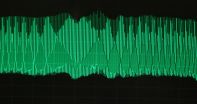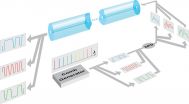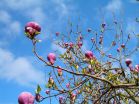(Press-News.org) Electrical engineers have broken key barriers that limit the distance information can travel in fiber optic cables and still be accurately deciphered by a receiver. Photonics researchers at the University of California, San Diego have increased the maximum power -- and therefore distance -- at which optical signals can be sent through optical fibers. This advance has the potential to increase the data transmission rates for the fiber optic cables that serve as the backbone of the internet, cable, wireless and landline networks. The research is published in the June 26 issue of the journal Science.
The new study presents a solution to a long-standing roadblock to increasing data transmission rates in optical fiber: beyond a threshold power level, additional power increases irreparably distort the information travelling in the fiber optic cable.
"Today's fiber optic systems are a little like quicksand. With quicksand, the more you struggle, the faster you sink. With fiber optics, after a certain point, the more power you add to the signal, the more distortion you get, in effect preventing a longer reach. Our approach removes this power limit, which in turn extends how far signals can travel in optical fiber without needing a repeater," said Nikola Alic, a research scientist from the Qualcomm Institute, the corresponding author on the Science paper and a principal of the experimental effort.
In lab experiments, the researchers at UC San Diego successfully deciphered information after it travelled a record-breaking 12,000 kilometers through fiber optic cables with standard amplifiers and no repeaters, which are electronic regenerators.
The new findings effectively eliminate the need for electronic regenerators placed periodically along the fiber link. These regenerators are effectively supercomputers and must be applied to each channel in the transmission. The electronic regeneration in modern lightwave transmission that carries between 80 to 200 channels also dictates the cost and, more importantly, prevents the construction of a transparent optical network. As a result, eliminating periodic electronic regeneration will drastically change the economy of the network infrastructure, ultimately leading to cheaper and more efficient transmission of information.
The breakthrough in this study relies on wideband "frequency combs" that the researchers developed. The frequency comb described in this paper ensures that the signal distortions -- called the "crosstalk" -- that arises between bundled streams of information travelling long distances through the optical fiber are predictable, and therefore, reversible at the receiving end of the fiber.
"Crosstalk between communication channels within a fiber optic cable obeys fixed physical laws. It's not random. We now have a better understanding of the physics of the crosstalk. In this study, we present a method for leveraging the crosstalk to remove the power barrier for optical fiber," explained Stojan Radic, a professor in the Department of Electrical and Computer Engineering at UC San Diego and the senior author on the Science paper. "Our approach conditions the information before it is even sent, so the receiver is free of crosstalk caused by the Kerr effect."
The photonics experiments were performed at UC San Diego's Qualcomm Institute by researchers from the Photonics Systems Group led by Radic.
Pitch Perfect Data Transmission
The UC San Diego researchers' approach is akin to a concert master who tunes multiple instruments in an orchestra to the same pitch at the beginning of a concert. In an optical fiber, information is transmitted through multiple communication channels that operate at different frequencies. The electrical engineers used their frequency comb to synchronize the frequency variations of the different streams of optical information, called the "optical carriers" propagating through an optical fiber. This approach compensates in advance for the crosstalk that occurs between the multiple communication channels within the same optical fiber. The frequency comb also ensures that the crosstalk between the communication channels is reversible.
"After increasing the power of the optical signals we sent by 20 fold, we could still restore the original information when we used frequency combs at the outset," said UC San Diego electrical engineering Ph.D. student Eduardo Temprana, the first author on the paper. The frequency comb ensured that the system did not accumulate the random distortions that make it impossible to reassemble the original content at the receiver.
The laboratory experiments involved setups with both three and five optical channels, which interact with each other within the silica fiber optic cables. The researchers note that this approach could be used in systems with far more communication channels. Most of today's fiber optic cables include more than 32 of these channels, which all interact with one another.
In the Science paper, the researchers describe their frequency referencing approach to pre-compensate for nonlinear effects that occur between communication channels within the fiber optic cable. The information is initially pre-distorted in a predictable and reversible way when it is sent through the optical fiber. With the frequency comb, the information can be unscrambled and fully restored at the receiving end of the optical fiber.
"We are pre-empting the distortion effects that will happen in the optical fiber," said Bill Kuo, a research scientist at the Qualcomm Institute, who was responsible for the comb development in the group.
The same research group published a theoretical paper last year outlining the fact that the experimental results they are now publishing were theoretically possible.
INFORMATION:
Paper Citation
"Overcoming Kerr-induced capacity limit in optical fiber transmission," by E. Temprana, E. Myslivets, B.P.-P. Kuo, L. Liu, V. Ataie, N. Alic and S. Radic from the Department of Electrical and Computer Engineering at the UC San Diego Jacobs School of Engineering. N. Alic and S. Radic are also affiliated with the Qualcomm Institute at the University of California, San Diego. This paper appears in the 26 June 2015 issue of the journal Science.
Research Funders
The authors thank Sumitomo Electric Industries for fibers used in the experiments, and Google Inc. for support of this work through a Google research grant.
Intellectual Property
The University of California has filed a patent on the method and applications of frequency-referenced carriers for compensation of nonlinear impairments in transmission.
PITTSBURGH--Scientific controversies, from problems replicating results - such as with the now debunked association between autism and MMR vaccines - to researcher misconduct and sensationalism, have led to speculation of "trouble at the lab," as the Economist put it.
The National Academy of Sciences (NAS) and the Annenberg Retreat at Sunnylands recently convened top scientists from Carnegie Mellon University, the University of California, Massachusetts Institute of Technology, Georgia Institute of Technology and other leading institutions to examine ways to return to ...
PITTSBURGH, June 18, 2015 - Researchers at the University of Pittsburgh School of Medicine have devised a computational model that could enhance understanding, diagnosis and treatment of pressure ulcers related to spinal cord injury. In a report published online in PLOS Computational Biology, the team also described results of virtual clinical trials that showed that for effective treatment of the lesions, anti-inflammatory measures had to be applied well before the earliest clinical signs of ulcer formation.
Pressure ulcers affect more than 2.5 million Americans annually ...
Chloroplasts, better known for taking care of photosynthesis in plant cells, play an unexpected role in responding to infections in plants, researchers at UC Davis and the University of Delaware have found.
When plant cells are infected with pathogens, networks of tiny tubes called stromules extend from the chloroplasts and make contact with the cell's nucleus, the team discovered. The tubes likely deliver signals from the chloroplast to the nucleus that induce programmed cell death of infected cells and prepare other cells to resist infection. The work is published online ...
Magnolias are prized for their large, colorful, fragrant flowers. Does the attractive, showy tree also harbor a potent cancer fighter?
Yes, according to a growing number of studies, including one from VA and the University of Alabama at Birmingham that is now online in the journal Oncotarget.
The study focused on squamous cell head and neck cancers, a scourge among those who use tobacco and alcohol. According to the National Cancer Institute, at least 3 in 4 head and neck cancers are caused by the use of tobacco and alcohol. The cancers have only a 50 percent survival ...
Without new conservation efforts, the Democratic Republic of Congo (DRC) could lose up to 20 percent of its forests, unleashing a 60 percent increase in carbon emissions, says a new study by researchers at the University of Vermont's Gund Institute for Ecological Economics.
Published by PLOS ONE, the study explores Central Africa's tropical forests, which are among the world's largest carbon reserves. While these forests have historically experienced low deforestation rates, pressures to clear land are growing due to development, foreign investment in agriculture, and ...
An international group of academic leaders, journal editors and funding-agency representatives and disciplinary leaders, including Rick Wilson, the Herbert S. Autrey Chair of Political Science and professor of statistics and psychology at Rice University, has announced guidelines to further strengthen transparency and reproducibility practices in science research reporting.
The group, the Transparency and Openness Promotion (TOP) Committee at the Center for Open Science in Charlottesville, Va., outlined its new guidelines in a story published in this week's edition of ...
Rainwater could save people in India a bucket of money, according to a new study by scientists looking at NASA satellite data.
The study, partially funded by NASA's Precipitation Measurement Missions, found that collecting rainwater for vegetable irrigation could reduce water bills, increase caloric intake and even provide a second source of income for people in India.
The study, published in the June issue of Urban Water Journal, is based on precipitation data from the Tropical Rainfall Measuring Mission (TRMM), a joint mission between NASA and the Japan Aerospace ...
The majority of the United States' poor aren't sitting on street corners. They're employed at low-paying jobs, struggling to support themselves and a family.
In the past, differing definitions of employment and poverty prevented researchers from agreeing on who and how many constitute the "working poor."
But a new study by sociologists at BYU, Cornell and LSU provides a rigorous new estimate. Their work suggests about 10 percent of working households are poor. Additionally, households led by women, minorities or individuals with low education are more likely to be ...
A new study led by researchers at Scripps Institution of Oceanography at UC San Diego indicates a steady population trend for blue whales and an upward population trend for fin whales in Southern California.
Scripps marine acoustician Ana Širović and her colleagues in the Marine Bioacoustics Lab and Scripps Whale Acoustic Lab intermittently deployed 16 High-frequency Acoustic Recording Packages (HARPs)--devices that sit on the seafloor with a suspended hydrophone (an underwater microphone)--to collect acoustic data on whales off Southern California from 2006-2012. ...
MINNEAPOLIS - A new study suggests that errors on memory and thinking tests may signal Alzheimer's up to 18 years before the disease can be diagnosed. The research is published in the June 24, 2015, online issue of Neurology®, the medical journal of the American Academy of Neurology.
"The changes in thinking and memory that precede obvious symptoms of Alzheimer's disease begin decades before," said study author Kumar B. Rajan, PhD, with Rush University Medical Center in Chicago. "While we cannot currently detect such changes in individuals at risk, we were able to ...




